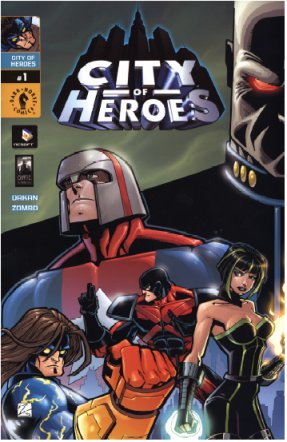It's
no secret that here at Fanboy Planet, NCSoft's multi-player
online role-playing game City of Heroes pretty much
has absorbed all of our spare time. And more. Not only is
it a perfect fit for several staffers' various obsessions,
it's just a danged cool game. The hardcore gaming community
seems to agree.
Naturally,
a game about superheroes lends itself to a comic book about
superheroes, and NCSoft had that base covered before release.
On the official
site, you can download a 16-page preview issue, and
subscribers to the game should automatically be sent the
regular book in the mail.
In
a marketplace that has recently seen a flood of titles about
cities overflowing with heroes (the best of which are things
like Powers, Astro City and Top Ten),
adapting a game in which it seems like there are more heroes
and villains than ordinary citizens poses a tough challenge.
For the casual reader unfamiliar or uninterested in the
game, how do you make this seem like something new?
Dakan
lifts the mythos straight out of the game, as naturally
enough, he also worked on its design. Paragon City still
cautiously rebuilds from the alien Rikti invasion, which,
though global, seemed to have centered on the city with
the highest superhero population.
But
trouble can come from the semi-human population without
any extraterrestrial help, as proven by the opening battle.
Heroes Apex and War Witch take on "zombie robots" that game
players may know better as Vhazilok's minions. Naturally
enough, the heroes don't know much about their foes, only
that they find them pretty disgusting. (Having been stuck
in enough fights with them myself, I agree. But I digress.)
Back
at their apartment hide-out (not really much of a hide-out,
as at least twenty other heroes live in the building), the
two get an unexpected visit from a flying hero, Horus, one
of the survivors of the Rikti Invasion. Together the three
try to trace the zombies to their source, and Dakan leaves
on a decent cliffhanger.
If the
description seems a little cramped, that's because so does
the comic. In this first issue, City of Heroes still
searches for a focus. The game doesn't so much offer characterization
as motives and fights, so when the book slows down for the
apartment sequences, Dakan has more exposition than real understanding
of Apex and War Witch. Through conversations we learn that
they are roommates, that Apex has a non-super sister, and
a few other details that provide setting, not insight.
Even
then, there's still not much in the way of why Paragon City
is such a focal point for superheroes or villains. Horus
questions why a character would become a minion of evil,
and it's doubtful that the answer will be much more complex
than "because." Story-wise, Dakan has not yet established
what makes this book different from all the other cities
of heroes books, other than this one is based on a game
everybody's playing. And if everybody's playing it, then
they're already getting this issue in the mail. It has to
have something to set it apart and keep it alive on the
stands.
The
art may do it. McKinney is more than competent, and though
he's been around for a little while, still has a rather
low-profile. He deserves a second look, showing a good sense
of character design and a pretty good handle on fight scenes.
Good thing, because this book will probably have a lot of
fight scenes.
Still,
City of Heroes the comic book just seems redundant
after the game, which have we mentioned kicks butt?
Rating:








